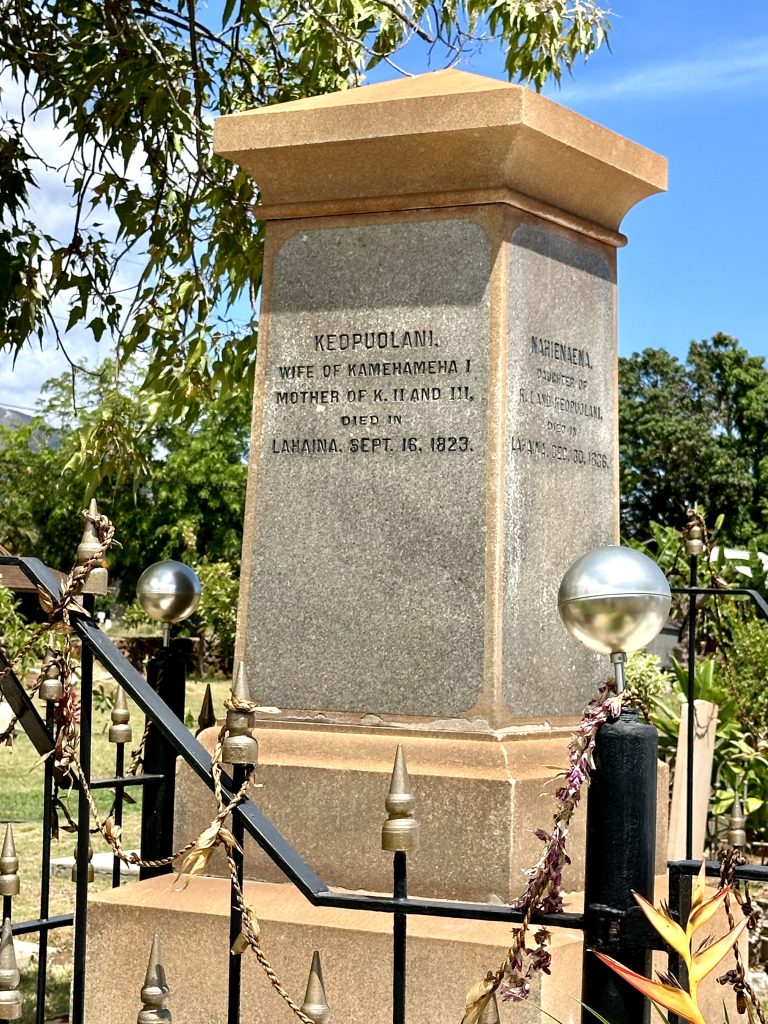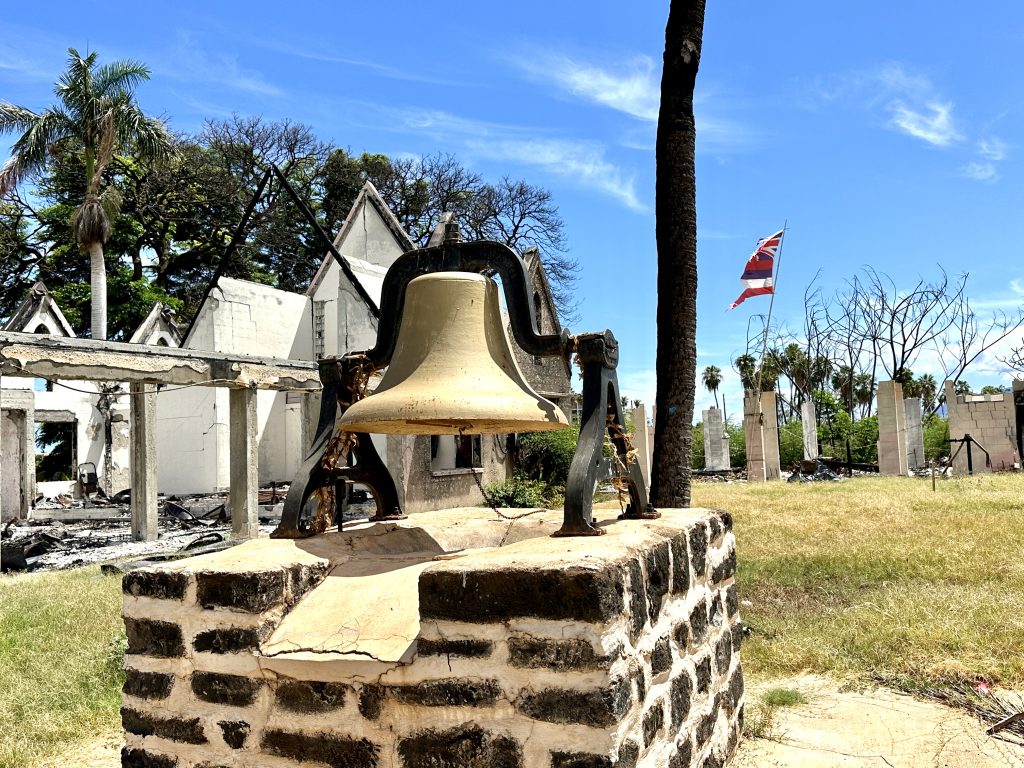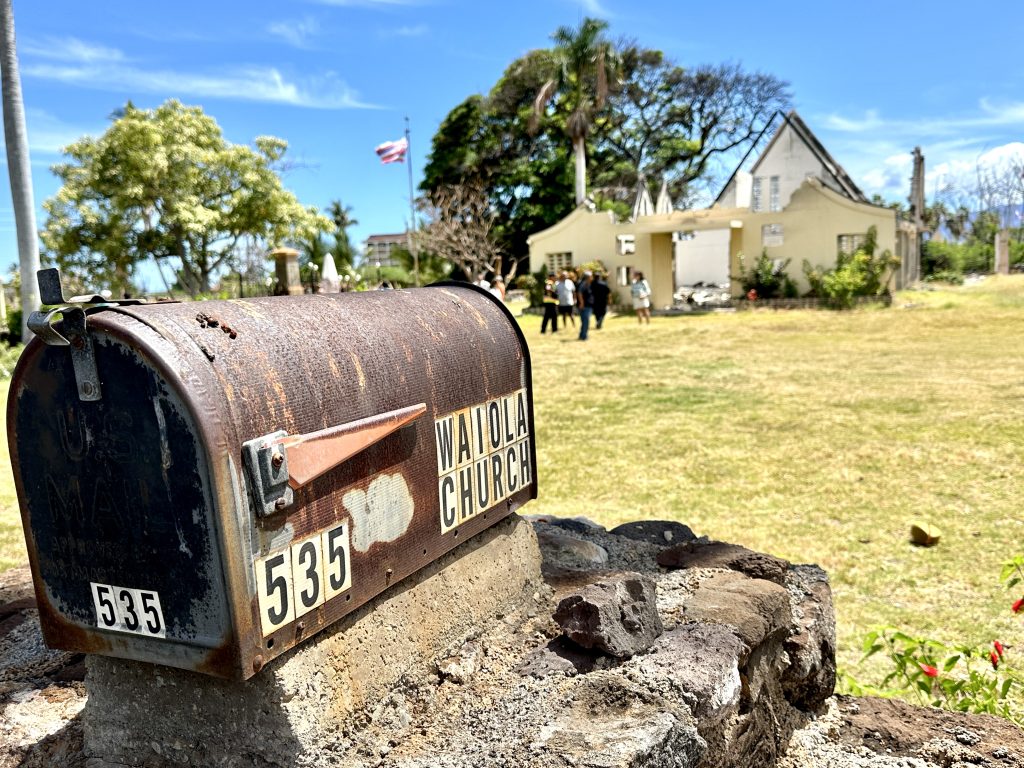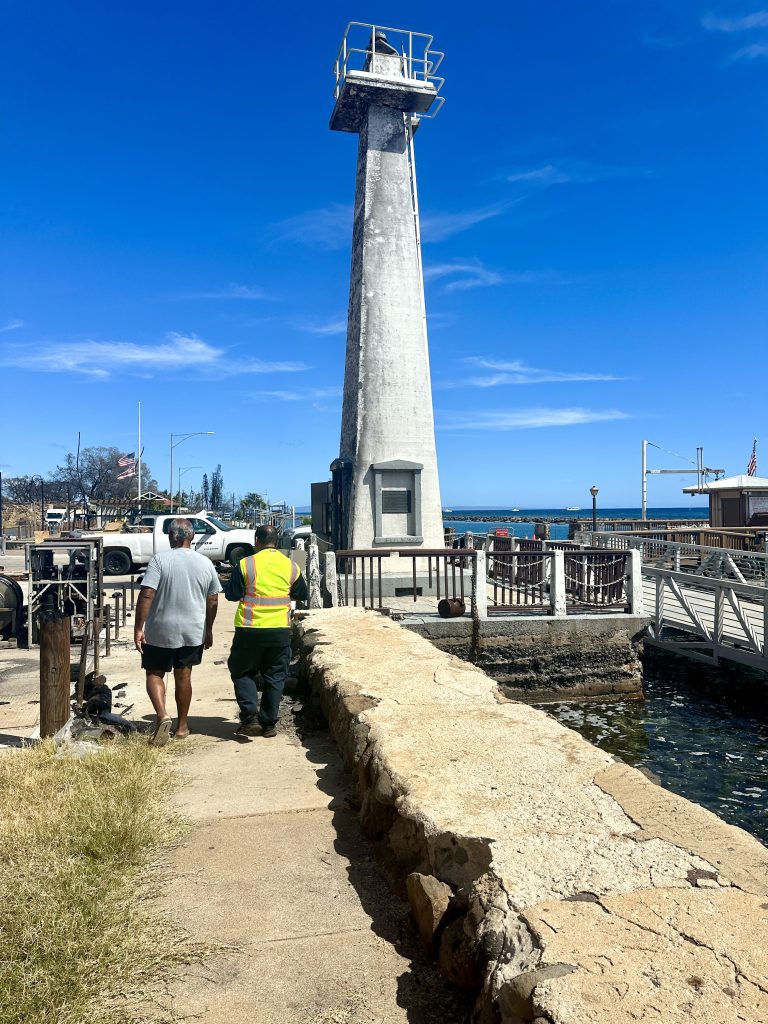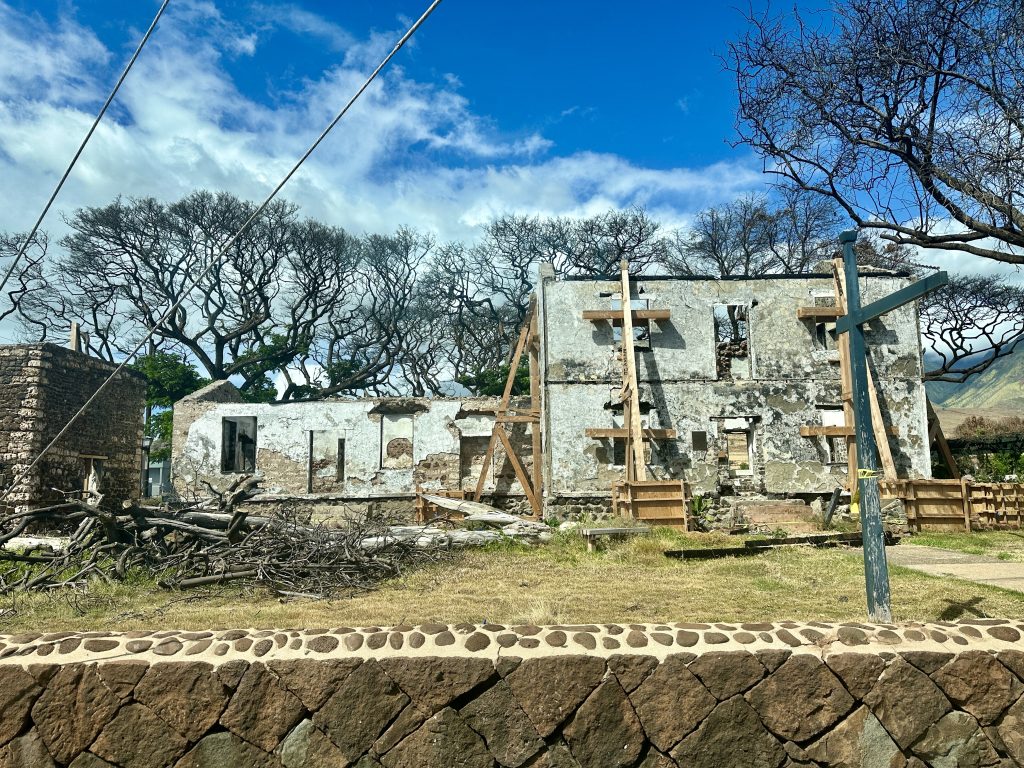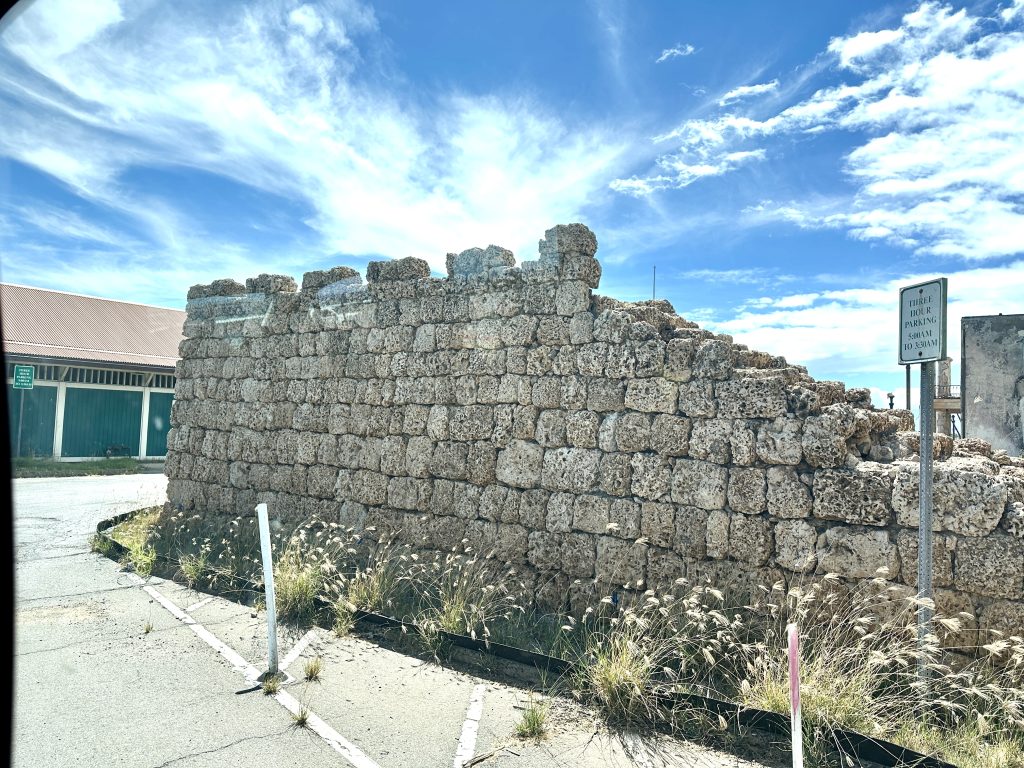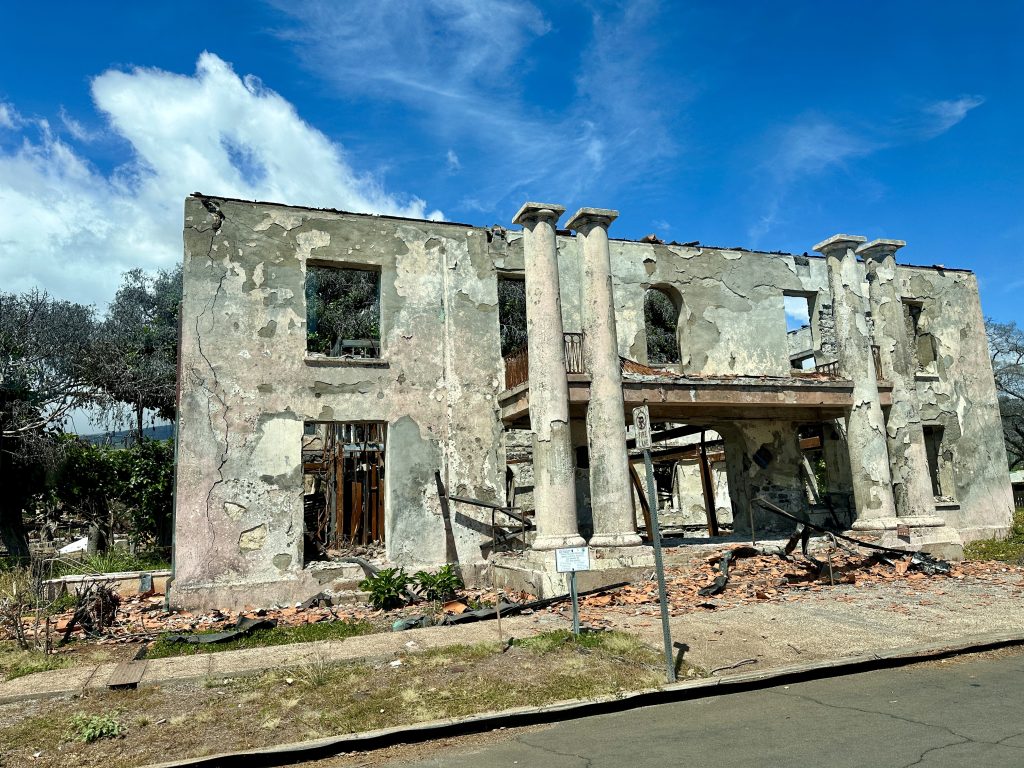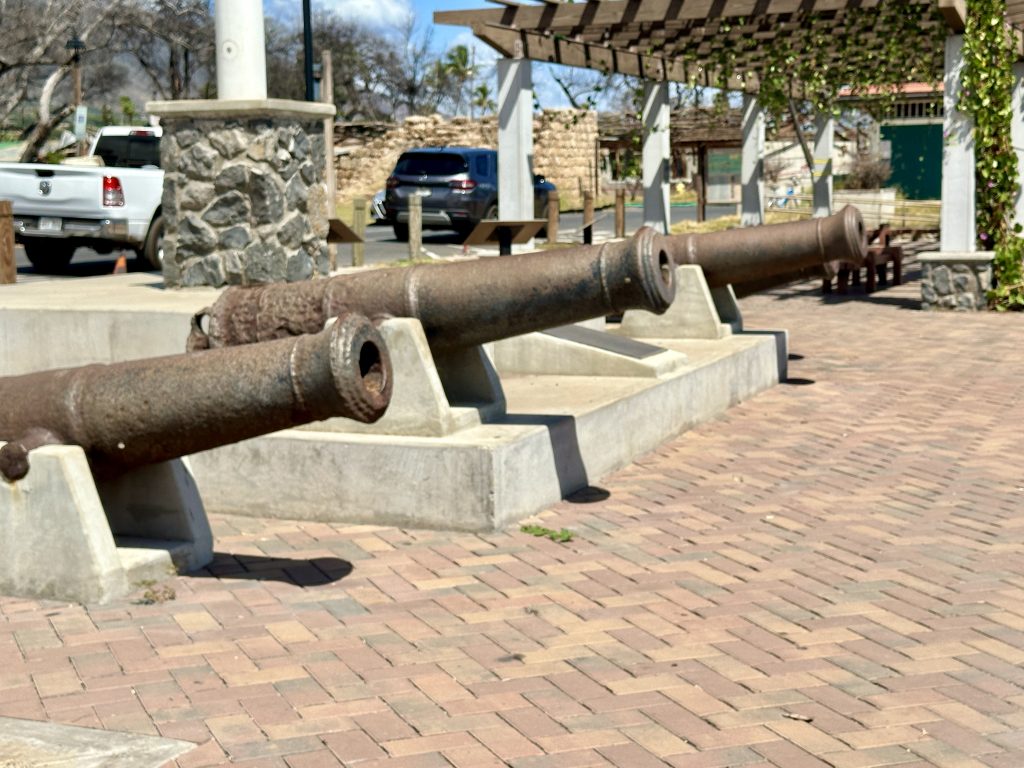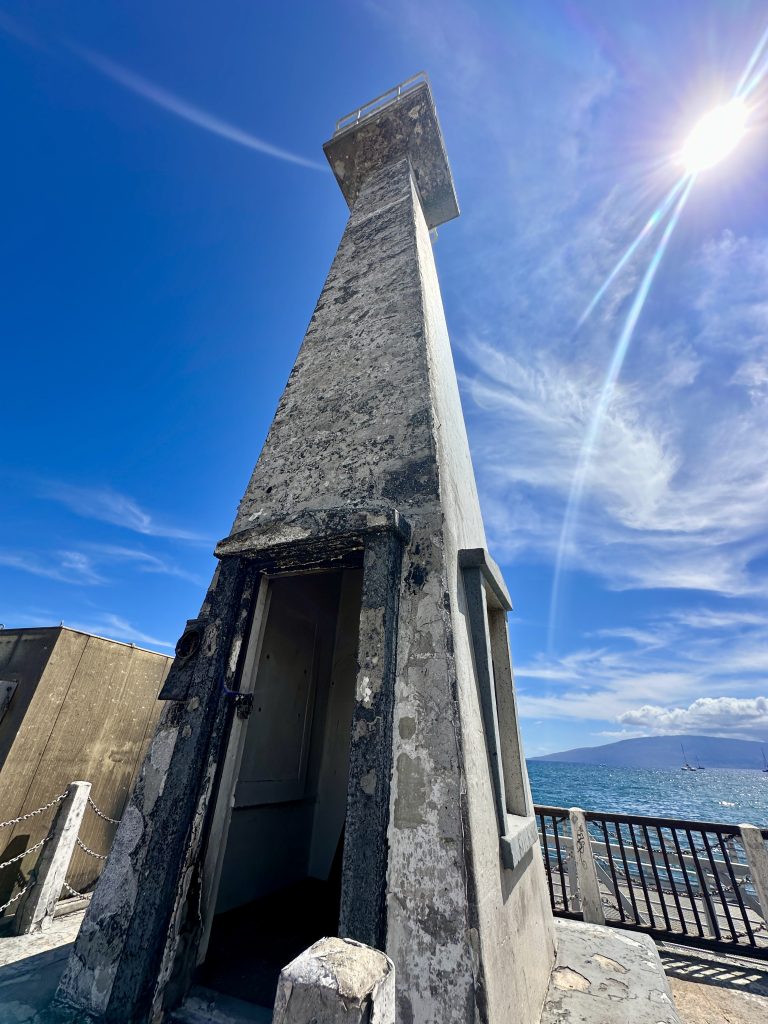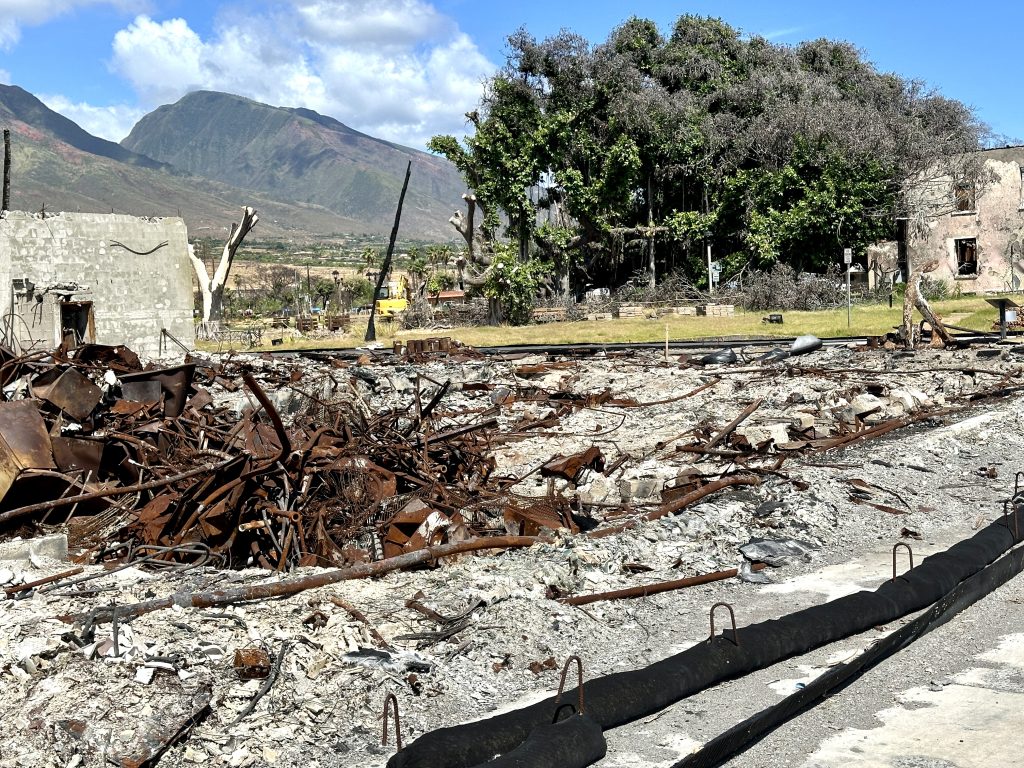Rep. Tokuda tours fire-ravaged Lahaina as process begins for National Heritage Area designation

US Rep. Jill Tokuda journeyed into Lahaina’s rich historic and cultural past with an eye on its future Wednesday.
The representative of Hawaiʻi’s second congressional district rode a shuttle bus through nearly deserted streets, amid fire-ravaged building ruins and metal shells of vehicles. She was accompanied by Native Hawaiian kupuna, cultural practitioners and others passionate about preserving the history of the former Hawaiian kingdom capital as it recovers from the Aug. 8 wildfires. The Lahaina disaster claimed 102 lives and destroyed more than 2,000 buildings, mostly homes, making thousands homeless.
“Historic and culturally significant places are an important part of our community stories,” Tokuda said after her visit. “They ground us to the land and connect us to the past in ways that can provide both meaning and guidance in our daily lives. The people of Lahaina will determine the future of their community, just as they would determine the future of this proposed National Heritage Area. While it is a national designation, at its core, it is about playing a supportive and uplifting role to a community’s vision.”
Helping to organize Tokuda’s visit was famed big wave surfer and waterman Archie Kalepa, a ninth-generation Lahaina resident and a member of Mayor Richard Bissen’s Lahaina Advisory Team. Other tour participants included Native Hawaiian cultural practitioner Ke‘eaumoku Kapu, cultural program coordinator of Nā ‘Aikāne o Maui Community Foundation; ‘Uilani Kapu of Nā ‘Aikāne o Maui Community Foundation; Lahaina Advisory Team member and Hi-Tech Maui President Kim Ball; Lahaina Restoration Foundation Executive Director Theo Morrison; and Kupuna Glenn Gazmen, Earle Kukahiko, Clayton Baybayan and Lillian Kalepa Suter.
The first tour stop for participants to get out and stretch their legs was at Waiola Church on Waine‘e Street. There, at the church originally built by Native Hawaiians from 1828 to 1832, Ke‘eaumoku Kapu led a prayer in Hawaiian, and Kukahiko tolled the church bell. The church’s front entrance and back walls stand largely intact, but its side walls are gone, except for frames.
According to the Lahaina Restoration Foundation’s pamphlet, the church could hold as many as 3,000 people seated on the floor. In 1858, the church was unroofed by a Kaua‘ula wind that also blew down its belfry. The church burned down in 1894 and 1947. Again, another Kaua‘ula wind blew apart the church in 1951.
Nearby is Waiola Cemetery where there’s a monument to Keōpūolani, wife of Kamehameha I, and mother of Kamehameha II and III. According to the foundation, the cemetery is the resting place of “chiefs and commoners, captains and sailors, missionary children and elders.”
During the tour, Ke‘eaumoku Kapu often pointed out street names that he said could be returned to their original, Hawaiian monarchy names. For example, Prison Street was originally named Pāpū Street. Pāpū means fortress in Hawaiian. Also, Luakini Street was called Alanui Nahi‘ena‘ena, which was a pathway cut for her 1837 stately funeral procession by her brother Kamehameha III.
Kapu showed wetland areas, including the burned-out site of 505 Front Street Shops & Restaurants. That oceanfront property was purchased by Canadian investors after the wildfire, he said. Its below-street-level parking area was full of water, which Kapu said showed that it’s in a wetland area.
The wetlands are in the vicinity of Mokuhinia Pond, which had been 14 to 17 acres filled with freshwater from underground springs surrounding the sacred island of Moku‘ula, a former sandbar that had served as a royal compound for the Pi‘ilani family of chiefs from the 16th century.
On Front Street is the burned out campus of Kamehameha III Elementary School, now temporarily located at the Pulelehua project area near Kapalua Airport. Ball mentioned that one of the school’s Lahaina campus building’s survived the fire, and he asked Kapu if there’s consideration to keeping the building intact as a fire memorial.
Kapu said numerous Hawaiian burials have been found at the site, and it’s unclear if the building can be saved or if the area can be used without disturbing burials of iwi, the sacred bones of ancestors that carry a person’s mana, or spiritual essence. “The whole campus; they found a lot” of burials, he said.
Further northwest, the tour shuttle turned into Wharf Street and stopped at Lahaina Harbor. Nearby, were the remains of Lahaina’s famed 60-foot-high Banyan Tree, the Lahaina Court & Custom House, the corner fort ruins and foundation and ashes of Pioneer Inn, built in 1901 by George Alan Freeland and the only hotel in West Maui until the early 1960s.
The Freeland family indicated during a recent Lahaina Advisory meeting that they would like to rebuild the hotel, and the Furtado family also plans to rebuild its structure off of Front Street, Kalepa said.
Last month, the House Natural Resources Subcommittee on Federal Lands held a hearing on the Lahaina National Heritage Area Act, introduced by Tokuda. The measure would begin the process of evaluating Lahaina for designation as a National Heritage Area.
A Congressional Research Service study on National Heritage Areas can be found here. The study lists 61 National Heritage Areas. The 62nd area was celebrated in May 2023 at the Southern Maryland National Heritage Area in Piscataway Park.
If successful, Lahaina would be the first National Heritage Area in the state of Hawai‘i, Tokuda said.
She said it’s unusual for a bill to even get a hearing in the sharply divided Congress, but her measure appears to have bipartisan support nevertheless.
The bill is the first step in a two-step process to establish a Lahaina National Heritage Area, she said. The measure calls for a feasibility study. It will look at, among other things, whether Lahaina has resources reflecting aspects of American heritage that are worthy of recognition, conservation, interpretation and continued use; whether it would benefit from public-private management; and whether a community of residents, businesses, nonprofit organizations, and state and local agencies would work to support it as a heritage area. Studies also must identify the possible boundaries of the proposed National Heritage Area, a potential management entity for the National Heritage Area, and the extent of financial resources available for the area, she said.
Once a study is complete, the Secretary of the Interior must submit a report to Congress that describes the study’s findings, correspondence reflecting support or opposition from stakeholders, and a recommendation as to whether to establish the National Heritage Area.
Tokuda said the National Park Service’s testimony during the bill’s hearing was supportive of her study bill, “so I hope the recommendation will be positive. It underscores the importance of community participation and involvement in the study once it begins.”
Lahaina’s designation as a National Heritage Area would open up federal funding opportunities, she said. These would “focus on preserving and perpetuating Lahaina’s unique historical, cultural and ecological assets that are community led and driven.”
Most National Heritage Areas receive a maximum of $1 million in federal funding annually, Tokuda said. The authorization of appropriations is created in the establishing legislation for the area. Federal authorization of appropriations is typically set for a period of time, most likely 10 years in Lahaina’s case, she said.
At the end of that initial period of authorization, there would need to be a re-authorization of appropriations, Tokuda said. “This allows the Appropriations Committee to continue to appropriate funding for the area. This typically happens as an omnibus lands bill, which re-authorizes appropriations for multiple national heritage areas at the same time.”
The federal funding is a 1:1 match in funding that is reliant on annual federal appropriations, according to Tokuda. The local coordinating entity would be Maui County. The county would be responsible for raising matching funds, which can come from state and county sources or private philanthropy.
The funding for the study outlined in the bill will come from the National Park Service, she said.
Ke‘eaumoku Kapu submitted written testimony to Congress in support of Tokuda’s bill. He noted that the August wildfires destroyed his organization’s Nā ‘Aikāne o Maui Cultural Center on Front Street. “With it, hundreds of artifacts documenting the history of our people were lost, including traditional feathered capes, historical maps, and old land deeds that could have helped other Native Hawaiian families reclaim their ancestral lands,” he said. “Despite all this loss, the work of Nā ‘Aikāne o Maui in protecting our culture and traditions will not cease.”
Earlier this month, the Board of Land and Natural Resources voted unanimously to issue an after-the-fact revocable permit to Nā ʻAikāne o Maui, Inc. for its Community Resource Center.
Establishing a National Heritage Area for Lahaina would go a long way in supporting the community’s efforts to preserve and protect this place that is central to our history and culture, he said. “The fires have given us a new opportunity to rebuild and restore Lahaina in a way that reflects its rich history and cultural heritage.”
Gov. Josh Green and Mayor Bissen also submitted testimony in favor of the bill.
“This designation would provide critical assistance to bring back important sites and help highlight the cultural significance of so many locations throughout Lahaina,” Bissen said. “This will not only help us in our efforts to rebuild and bring back Lahaina, but it is also a clear testament to Lahaina’s rich heritage and a recognition of its importance to our people, our history, and to Hawai‘i.”
“I can think of no better place to be the first National Heritage Area in the State of Hawai‘i,” he said.





